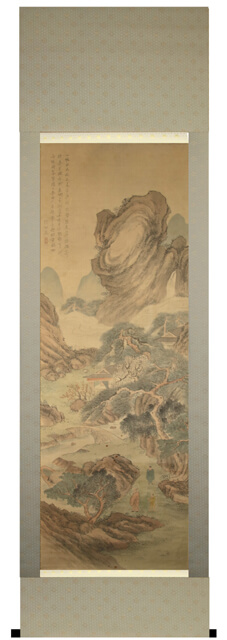A Case of an Imperfect Kakejiku Stain Removal

A Case of an Imperfect Kakejiku Stain Removal
One of the common inquiries regarding art objects such as kakejiku is to find the solution of stain problems.
As the cause of the nuisance varies, the state of them is widely ranged.
No matter how many stain removal methods there are, sadly stubborn stains which hardly been gotten rid of exist and that makes us wonder if these stains can be generalized as ‘stain’…
We are not exaggerating; stain removal is probably the toughest task for scroll mounters.
The episode this time is about one of those works requested by a male customer living in the U.S.
Here is the piece. We hear that the former owner cut the upper and bottom part of the kakejiku to place it in a frame. The customer told us that by remounting, he would like to give the piece a second life as a kakejiku.

There were noticeable dark brown stains at the bottom of the artwork.

The remounting work was to undertake once we gain the customer’s acceptance of the possibility of the incomplete stain removal with the stains this dark.

Consultation for the Details
We had a consultation for the details with the customer and we settled to execute the following procedure.
The stain removal: There is a possibility that the stain will not be perfectly clean.
Mounting style: Maru mounting style
Options: Ichimonji-otoshi, paulownia box
Mounting fabric: See the picture below.
Repair Process
The rough flow of remounting operation for this time is as follows:
Color Fixing (Settling the paint by applying chemical agent)
↓
Dismantling of Kakejiku (Removing old fabrics, roller rod, etc.)
↓
Removal of Old Backing Paper (Peeling off the old backing paper from the back of the main work)
↓
Cleaning (Cleaning the main work as best as possible by using chemical agent)
↓
Remounting (Remounting in kakejiku with the fabric which the customer has chosen)
Removing the stains. Individual stains aren’t targeted instead a stain removing solution is spread all over the piece.

As we guessed, the stubborn stains died hard. The task must be done super delicately while avoiding run of the paint and discoloration of the whole artwork as a result of an overpowering removal and it could be ended uncompleted balancing the result with the negative effects on an undertaken artwork.

Completion of the Restoration
The procedure also cleaned the entire piece which was covered with dirt and the color of the artwork was revived.
若Although the stains remain vaguely still they are apparently paler and more unnoticeable than their former state. That point was as far as we could go.
Before shipping the piece we gave the customer notice that the stains weren’t completely removed while showing the photo.
The customer who is kind enough to thoroughly understand our mounting work was delighted by our expertise.
Dear Nomura-san:
Thank you for your email reply and update. I appreciate your trying to remove the stains and I think your decision not to over-clean the area is the right one. It looks just fine to me.
Here is his feedback once he reunited with his art piece we had sent.
I was delighted to find it looking so good after your fine remounting. Your work looks first rate!! And the box and box container are also of very good quality. I really appreciate your fine craftsmanship.
We feel absolutely privileged to know he feels grateful, showing his respect for our work attempted as best as we could.
As you see in this topic, a perfect removal of stains on kakejikus or pieces of art is not always guaranteed yet we will undertake the task for your artworks as far as we possibly could.
So please don’t hesitate to contact us if you have any concern over these issues.


